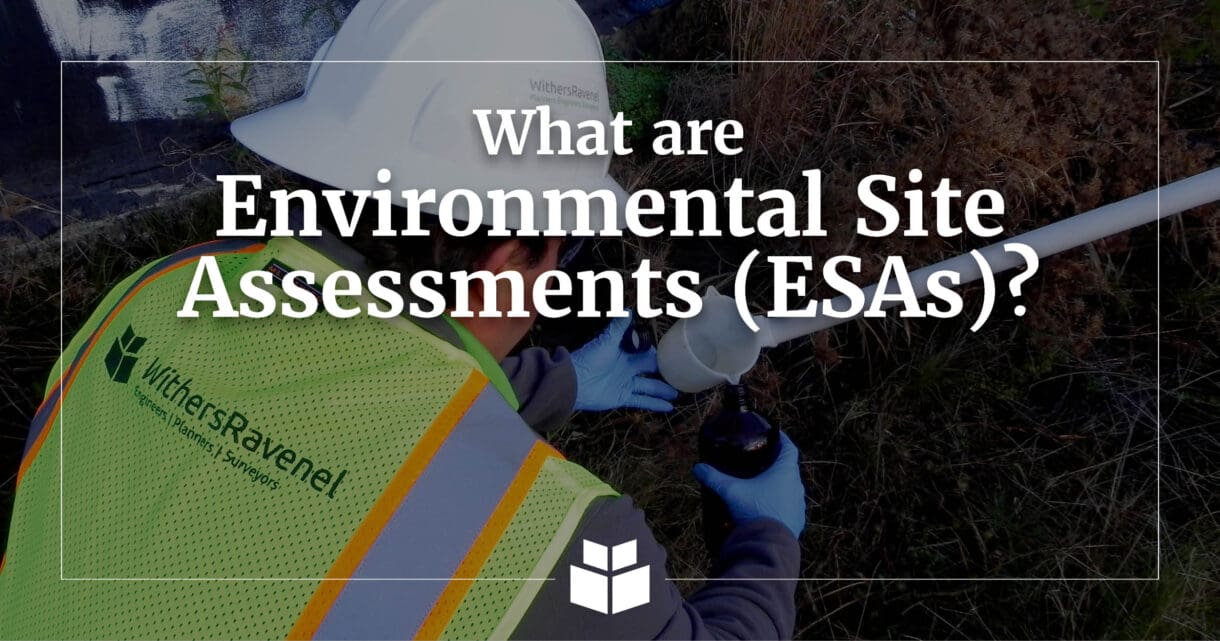
WithersRavenel’s Environmental team provides site assessments for properties identified for current or planned projects. An Environmental Site Assessment (ESA) in North Carolina evaluates potential risks or contamination on a property, typically conducted before property transactions, development, or financing. It helps identify liabilities, ensure regulatory compliance, and helps buyers, lenders, or investors make informed decisions. The process is primarily guided by the American Society for Testing and Materials (ASTM) standards, particularly ASTM E1527-21 for Phase I ESAs.
Why is an ESA needed?
While primarily it helps property buyers and owners avoid costly cleanup costs and issues down the road, these assessments and follow-up compliance provide legal protection to site owners.
What is a Phase I ESA?
Phase I is a non-invasive investigation to identify potential or existing environmental contamination liabilities, known as recognized environmental conditions (RECs). It provides due diligence for property transactions and qualifies for liability protections under CERCLA (Comprehensive Environmental Response, Compensation, and Liability Act), commonly known as Superfund.
For Phase I, our environmental team typically follows these steps:
- Historical Records Review: This can involve going over historical records, aerial photographs, city directories, and chain-of-title documents to understand past land use to identify potential environmental concerns. For instance, if a certain site may have been previously used for storing hazardous materials.
- Database Searches: Our team will scour records in federal, state, and local databases to identify any past contamination or hazardous waste issues at a property or sites nearby.
- Site Inspections: The next step is often visiting the site and doing a visual inspection to identify contamination, such as underground storage tanks, chemical spills, or stressed vegetation. We often meet with previous or existing owners and local officials to corroborate any conclusions drawn from our inspections.
- Report: And, finally, based on our findings, our environmental team compiles a report, which could recommend further recommendations such as a Phase II recommendation. The report ensures compliance with the All Appropriate Inquiries (AAI) rule under CERCLA.
What is a Phase II ESA?
Our environmental team digs deeper, figuratively and literally, during Phase II ESAs, which unlike Phase I is an invasive investigation to confirm and quantify contamination found in Phase I RECs. This phase requires physical sampling and testing to find the presence of any contaminants, and to understand the extent of contamination. The timeline for these assessments and final report varies, depending on the complexity of a given site and findings reported by the laboratory.
For Phase II, our environmental team typically follows these steps:
- Sampling and Testing: We collect samples of soil, groundwater, surface water, or soil vapor to analyze for hazardous substances such as petroleum hydrocarbons and heavy metals in a laboratory. To collect these samples, field crews can drill, install monitoring wells.
- Site Assessment: Our team could assess contamination levels, migration pathways, and site characteristics to evaluate risks to human health, ecosystems, or property value. This may include assessing vapor intrusion risks into buildings. Samples are analyzed in accredited labs to measure contaminant levels against a local or state authority’s goals and standards.
- Report and Recommendations: The findings lead to the report detailing whether contamination exceeds regulatory thresholds. We will then recommend remediation options or land-use controls, if needed. If findings show contamination exceeds unrestricted use levels such as residential standards, property owners must consent to site-specific remediation plans, and public notification may be required under a state’s regulations.
Learn how we can help you with your environmental assessment. Reach out to WithersRavenel Environmental Due Diligence Manager Lindsey Woolridge for more information at lwoolridge@withersravenel.com.
